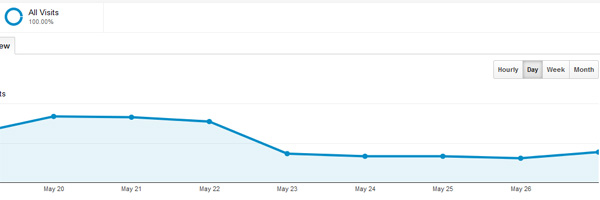

Google Penguin looks to identify websites who are ranking due to links that violate Google's terms. These could be:
Penguin simply says "now that I understand those links are spammy I will remove their value and move your website to the place in the rankings where it would be if those links did not exist".
In other words there is no penalty.
This is to make sure negative SEO (such as competitors buying spammy links and pointing them to your site) has no effect.
If you have seen a sudden drop in visitor numbers then it is easy to assume your site must have been hit by a Google Penguin update. This is however, not always the case.
To start with carry out these initial checks:
It is important to do both of the above as it is possible to have been hit by both Penguin and a manual penalty at the same time.
It is not uncommon for a website to take a hit on a Penguin rollout date but not actually be hit directly. I call this the Penguin red herring.
This occurs when a website relies on a small number of inbound links from other sites and one or more of those sites has been hit by Penguin. That means those websites have lost their rankings, and standing, with Google and so any link juice they were passing on to your site has now been lost.
If you have no warning messages in your Google Webmaster Tools and your site does rely on a small number of links do not forget to consider this as a possibility as it will affect how you handle the situation.
Here is a good example of something that looked like a Penguin hit.

This is a shot of a Google Analytics page showing a sudden slump in visitor numbers around May 22nd and 23rd of 2013. Checking this against the record held by moz.org we do indeed see that Penguin 2.0 was released on May 22nd.
However in reality it turned out that this particular site was not hit by Penguin. The site was actually relying on 6 backlinks for its rankings and it was two of these sites which were actually hit.
In this instance the correct action to take was to look for some proper high quality links that could replace those that were lost. The incorrect action would be to waste time with removing links or using the disavow tool.
Google Penguin does make some people think that all they need to do to bring a competitor's site down is to purchase large numbers of spammy links and point them at their competitor's site.
Not that simple.
To understand why this is so you need to understand how Penguin is applied.
All Penguin does is realise there are a number of links which have no value, withdraw any rankings value it had given your site because of these links and move you to the correct place in the index/search results. It is a natural re-adjustment now that Google understands your link profile was not all it seemed to be.
So if a competitor had been buying spammy links and pointing them at your site you may have benefited for a short while but that time is now over. If it was you who were buying the spammy links that is now money wasted.
So long as there are no manual penalties being applied then any recovery is simply the same as any "new" website - in other words you just need good quality links to get good rankings.
You do not need to disavow the spammy links or try to get them removed or submit reconsideration requests to Google. In fact to do so may only flag your site up and lead to a manual penalty before you have time to get a good quality backlink profile in place.
How you go about creating that stronger back link profile is the key and of course the most common advice is to have a website/content that people will actually want to link to (and thus save you the effort of link building).
But if you are working in a very competitive environment you may want to speed this process up via everything from guest blogging to getting your brand featured/quoted in well known publications or on highly respected websites.
Of course if you were behind the spammy links, or a SEO company you hired was, then you remain in danger of a manual action (a real penalty) from Google.
In this case you should work through and remove the links before they are spotted in a manual review. Do not use the disavow tool until:
The above is vital because many webmasters actually end up reporting themselves to Google and receiving a manual penalty because they called attention to their situation via the disavow tool!
One hundred, one thousand or one hundred thousand spammy links cannot bring a site down when it comes to Penguin. Penguin doesn't push websites down (only Manual Actions do).
This is why many in the spamming and bulk link selling business call their products "Penguin Proof". They will sell you links that Penguin will then identify as useless and ignore but it won't penalise you.
As such you can't really Penguin proof a site, you just need to get on with clean SEO...!